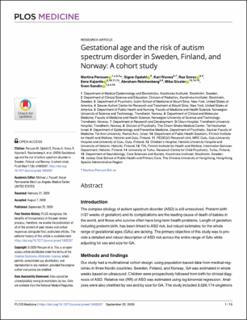| dc.description.abstract | Introduction
The complex etiology of autism spectrum disorder (ASD) is still unresolved. Preterm birth (<37 weeks of gestation) and its complications are the leading cause of death of babies in the world, and those who survive often have long-term health problems. Length of gestation, including preterm birth, has been linked to ASD risk, but robust estimates for the whole range of gestational ages (GAs) are lacking. The primary objective of this study was to provide a detailed and robust description of ASD risk across the entire range of GAs while adjusting for sex and size for GA.
Methods and findings
Our study had a multinational cohort design, using population-based data from medical registries in three Nordic countries: Sweden, Finland, and Norway. GA was estimated in whole weeks based on ultrasound. Children were prospectively followed from birth for clinical diagnosis of ASD. Relative risk (RR) of ASD was estimated using log-binomial regression. Analyses were also stratified by sex and by size for GA. The study included 3,526,174 singletons born 1995 to 2015, including 50,816 (1.44%) individuals with ASD. In the whole cohort, 165,845 (4.7%) were born preterm. RR of ASD increased by GA, from 40 to 24 weeks and from 40 to 44 weeks of gestation. The RR of ASD in children born in weeks 22–31, 32–36, and 43–44 compared to weeks 37–42 were estimated at 2.31 (95% confidence interval [CI] 2.15–2.48; 1.67% vs 0.83%; p-value < 0.001), 1.35 (95% CI 1.30–1.40; 1.08% vs 0.83%; p-value < 0.001), and 1.37 (95% CI 1.21–1.54; 1.74% vs 0.83%; p-value < 0.001), respectively. The main limitation of this study is the lack of data on potential causes of pre- or postterm birth. Also, the possibility of residual confounding should be considered.
Conclusion
In the current study, we observed that the RR of ASD increased weekly as the date of delivery diverged from 40 weeks, both pre- and postterm, independently of sex and size for GA. Given the unknown etiology of ASD and the lifelong consequences of the disorder, identifying groups of increased risk associated with a potentially modifiable risk factor is important. | en_US |

